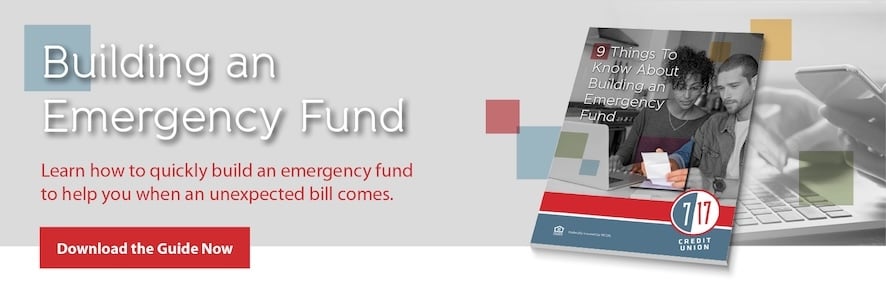- 7 17 Staff
When You Should Use Your Emergency Fund

An emergency fund is an essential component of personal finance and is often tied to financial wellness. But what isn’t often discussed is when you should dip into your emergency fund. This is further complicated by rising interest rates and inflation that have made things feel more difficult lately. Here’s some guidance for when it may be necessary to withdraw from your emergency fund and how to protect the money in it as much as possible.
When Should You Dip Into Your Emergency Fund?
It can be a bit frightening at first to tap into an account you’ve spent some time building, but it’s a better option than taking on debt. You don’t want to make a rash decision. So how can you tell when you should dip into your emergency fund?
First, ensure that you’ve used all the financial tools you have at your disposal. For example, if you’re experiencing a job loss, file for unemployment benefits. If you’re having trouble paying rent or making your mortgage payment, reach out to your lender or landlord and discuss your situation with them. By doing this, you may discover options you didn’t know about.
If finances are simply tight, which is common during times of high inflation, consider re-evaluating your budget and cutting back on any areas you can, such as takeout, subscription services you no longer use and unnecessary shopping trips. It also helps to be strategic with necessities. For example, look for alternatives to your favorite food items, such as using store-brand items instead of name brands. If after taking these steps you still can’t afford to pay for necessities, it may be a good time to use your emergency fund.
It may also be a good time to access your emergency fund if you’re experiencing unexpected home or auto repairs or medical bills and need a large amount of funds to cover these expenses right away.
What To Avoid Using Your Emergency Fund For
Major one-time costs can catch anyone off guard, but they may not be emergencies. Not sure if the expense counts as an emergency? Ask yourself the following question: “Do I need this item to survive?”
If you don’t, then think twice about using your funds for the expense. For example, predictable expenses like replacing your washing machine or dishwasher may not be an emergency. Save your emergency fund for situations when you would otherwise be forced to accumulate credit card debt as your last resort.
Tips for Rebuilding Your Emergency Fund
After dipping into your emergency fund, you need to consider how to rebuild it. It can take some time to rebuild your fund, but if you incorporate the following savings strategies, you may be able to have funds in your savings account again within a year or so:
- Start small: You likely won’t be able to replace the amount you took out of your emergency fund all at once. It’s okay to start small and gradually increase the amount you put into your savings.
- Set up automatic transfers: Make saving automatic so you don’t have to think about it. Setting up regular automatic transfers can help with rebuilding your emergency fund so you don’t have to remember to transfer money.
- Scale back your budget: It may help to rebuild your savings by scaling back on your budget for a bit. For example, you may choose to limit discretionary spending like entertainment or dining out.
- Put funds into an interest-bearing account: Don’t let your money sit idle. Find an account that pays out interest dividends on your money. This will increase your balance and financial security over time.
Be Prepared for the Unexpected
Starting an emergency fund and keeping the money in it can be easier said than done. Learn more about how to improve your financial stability and carry yourself through unexpected financial emergencies in our comprehensive guide, “How to Build an Emergency Fund: 9 Things to Know”.
